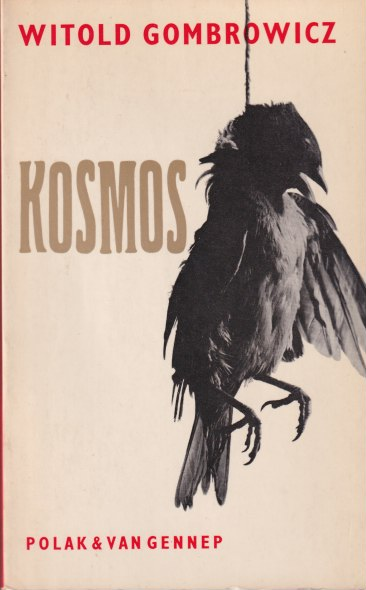The DECODER series — to which SEMIOVOX has invited our semiotician colleagues from around the world to contribute — explores fictional semiotician-esque action as depicted in books, movies, TV shows, etc.
Born out of chaos, we can never encounter it again, no sooner do we look than order and form… are born under our very eyes.
Kosmos, trans. D. Borchardt
Kosmos (translated into English as Cosmos) is not an ordinary piece of fiction. One can read it as a weird detective story, an ironic existential treatise, metaphysical thriller, or even an uncanny erotic novel. First published in Paris in 1965, it is one of the most enigmatic yet ingenious writings in Polish literature of the 20th century — and the last novel of Witold Gombrowicz, an author boldly claiming to be the predecessor of all structuralists.
The story follows two friends who meet on their way to spend a summer in the Carpathian Mountains. Regular holidays, however, quickly take an odd turn, when the main narrator — Witold — and his buddy Fuks stumble upon a dead sparrow, hanging from a branch on a string. In the randomness of the surrounding landscape, the discovery seems eccentric, extraordinary, effervescing with meaning. “It seemed to fluff its feathers, put on airs and pretend to be more important than it really was,” as Witold remarks. The sparrow becomes a catalyst for and obsessive as well as hilarious quest for meaning. Found or fabricated occurrences that follow the hanged bird (including a dangling stick, a suffocated cat, disfigured lips, a vomiting mouth) are understood by the hero to be somehow connected, analogous, referring to one another — constituting an unknown, signifying universe forcing itself upon the protagonist.
The investigation is not an easy enterprise since it is constantly disrupted by other pressing constellations, from made-up languages to the detailed eating peculiarities of supporting characters. Nevertheless, Witold can’t cease his search — as the eerie feeling that “something [is] trying to break through and press toward meaning” is driving a frantic desire to decode signs that impose themselves on him. He seeks to reach the meaning-making rule… but he cannot.
To describe the idea of the semiosphere, Juri Lotman declares that “by sticking together individual steaks, we don’t obtain a calf; but by cutting up a calf, we may obtain steaks.” The semiosphere is a unified universe, and not simply a sum of separate semiotic occurrences. Yet what Witold is trying to do is put together scraps of meat (not even steaks), as he is unable to assign meaning to any of the phenomena he encounters. He just feels that they belong together and gravitate towards some sort of meaning that is concealed from him. The “calf” tries to break through, the constellation of signs tries to disclose its meaning, but it is never unveiled.
Kosmos is the great example of the semiotician’s ultimate struggle — since to decode entrails not only “reading” signs in their isolation but determining their part in a broader universe of meaning. Those small fragments of an undisclosed cosmos are our only way to reach the semiosphere — at which point we’ll understand how meaning arises and is being transmitted. However, we can’t simple add the fragments up. The occurrences upon which we stumble may push, demanding semioticization, but the semiosphere is not pushy. The object of semioticians’ desire, it seductively lurks just out of our reach.
DECODER: Adelina Vaca (Mexico) on ARRIVAL | William Liu (China) on A.I. ARTIFICIAL INTELLIGENCE | Tim Spencer (England) on VURT | Ramona Lyons (USA) on BABEL-17 | Rachel Lawes (England) on NICE WORK | Alfredo Troncoso (Mexico) on THE ODYSSEY | Gabriela Pedranti (Spain) on MUSIC BOX | Charles Leech (Canada) on PATTERN RECOGNITION | Lucia Laurent-Neva (England) on LESSONS IN CHEMISTRY | Whitney Dunlap-Fowler (USA) on THE GIVER | Colette Sensier (England / Portugal) on PRIESTDADDY | Jamin Pelkey (Canada) on THE WONDER | Maciej Biedziński (Poland) on KOSMOS | Josh Glenn (USA) on LE GARAGE HERMÉTIQUE | Antje Weißenborn (Germany) on BABYLON BERLIN | Ximena Tobi (Argentina) on SIX FEET UNDER | Mariane Cara (Brazil) on ROPE | Maria Papanthymou (Greece) on MY FAMILY AND OTHER ANIMALS | Chirag Mediratta (India) on BLEACH | Dimitar Trendafilov (Bulgaria) on THE MATRIX | Martha Arango (Sweden) on ONE HUNDRED YEARS OF SOLITUDE | Becks Collins (England) on THE HITCHHIKER’S GUIDE TO THE GALAXY | Ivan Islas (Mexico) on THE NAME OF THE ROSE | Paulina Goch-Kenawy (Poland) on THE SENSE OF AN ENDING | Eugene Gorny (Thailand) on SHUTTER ISLAND & FRACTURED.
Also see these global semio series: MAKING SENSE (Q&As) | SEMIOFEST SESSIONS (monthly mini-conferences) | COVID CODES | SEMIO OBJECTS | COLOR CODEX | DECODER (fictional semioticians) | CASE FILE | PHOTO OP | MEDIA DIET.


